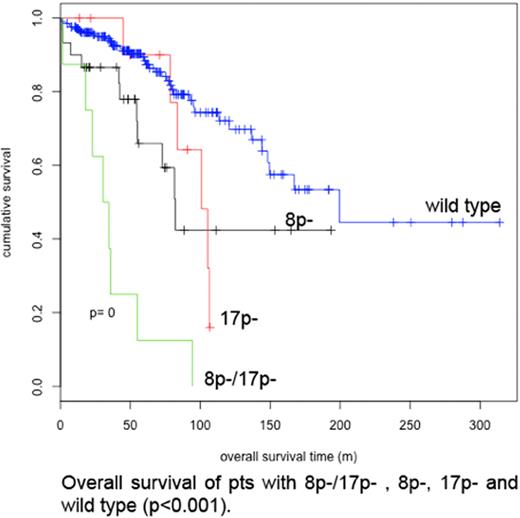Abstract
Abstract 2339
Poster Board II-316
CLL, the most common adult-onset leukemia in the Western world, has a heterogeneous clinical course. Many advances have led to a better understanding of its pathogenesis and to improvements in treatment strategies, but striking solutions are still missing. We conducted a study to evaluate the impact of genomic aberrations on the clinical course.
From January 1980 to May 2008, 395 frozen samples of CLL patients, were prospectively collected in four centers. Extracted DNA was analyzed with Affymetrix Human Mapping 6.0 arrays. Normal matched DNA was analyzed for one fourth of the cases. Correlations between minimal common regions (MCR) and clinical parameters were evaluated with the Fisherôs-exact test and their impact on OS with the log-rank test. A p-value after Bonferroni multiple test correction (MTC) (p-adj.) <0.05 was considered as statistically significant. Up to now 266 samples have been analyzed.
Analysis of the clinical parameters (CPs) and known risk factors (Rai/Binet, age, doubling time, LDH, beta2, IGVH status, p53 mutations, telomere length, CD38, 11q, 17p) was consistent to previous published series. ZAP70 did not affect the clinical course, likely due inter-laboratories variability. After a median follow up of 53 months, 143/239 (60%) of the patients have started therapy and 63/261 (24%) died. 5-yr OS was 82%. Fisher test between the MCRs and CPs revealed an inverse relation between the presence of trisomy 12 by FISH and del13q14.3, an association between del17p and losses of 8p regions and between CD38 and 12q gain. Before MTC, 46 MCRs had a significant impact on OS and 67. After MTC, 3 regions maintained their role: 8p22 loss (38/248, 15%, p-adj.=0.002, median OS: 26 months vs. 48), 17p13.3-11.2 loss (20/248, 8%, p-adj.=0.001; median OS: 10 months vs. 48). In univariate analysis, the log-rank test among pts with 8p-/17p- (8/248, 3%), 8p- (30/248, 12%), 17p- (12/248, 5%), wild type (198/248, 80%) was statistically significant (p<0.001; see figure). Importantly, none of the analyzed clinical and biological parameters was associated with this aberration.
Loss of 8p22 designated a CLL subgroup with a worse outcome among all patients and in the subset with 17p loss. Our data suggested that this aberration might constitute an independent prognostic factor to be evaluated in independent studies. Results, including a Cox regression model, will be presented on all 395 cases.
No relevant conflicts of interest to declare.
Author notes
Asterisk with author names denotes non-ASH members.


This feature is available to Subscribers Only
Sign In or Create an Account Close Modal